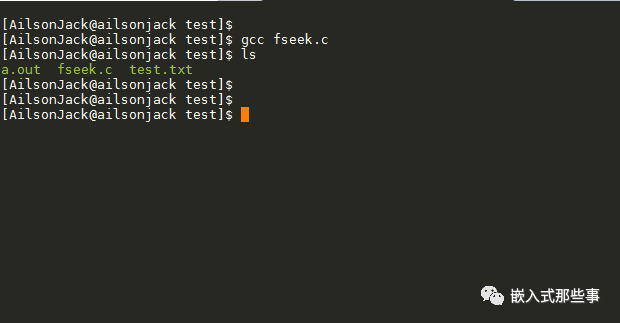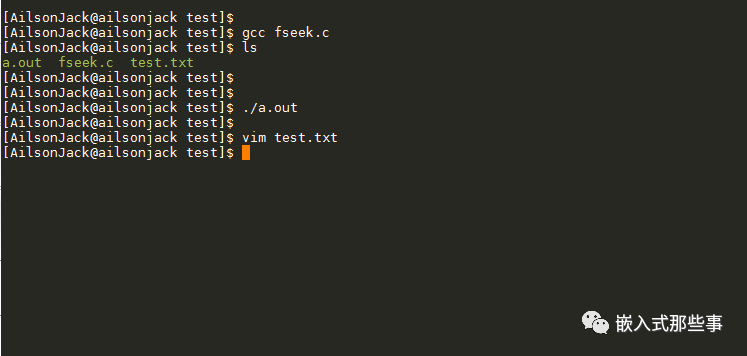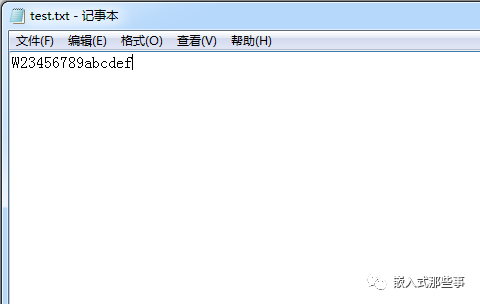

C语言-fseek不起作用写操作定位无效简析
描述
情况说明
最近在写一个操作文件的函数,使用fseek()函数定位到文件某个位置,然后用fwrite()重新更新该位置的内容,发现该位置处的内容并没有更新,反而更新的内容竟然出现在了文件末尾,真的是不知道什么情况。
问题复现
下面先简单复现我所遇到的问题吧,示例代码如下:
/* *By:Ailson Jack *Date:2019.01.24 *Blog:www.only2fire.com *Des:fseek 测试 */ #includeint main(void) { char *fileName = "test.txt"; char ch = 'W'; FILE *fp = NULL; int iRet = 0; fp = fopen(fileName, "a+"); if (!fp) { printf("open %s failed! ", fileName); return -1; } iRet = fseek(fp, 0, SEEK_SET); /*定位指针到文件头*/ if (iRet < 0) { printf("fseek failed! "); fclose(fp); return -1; } fwrite(&ch, 1, 1, fp); /*向文件中写入单个字符 'W'*/ fclose(fp); return 0; }
将上述代码编译,然后在编译输出文件所在的文件夹中创建一个test.txt文件,内容为:
123456789abcdef

2019-01-24_185403

2019-01-24_185449
接着运行程序,打开test.txt,可以看到内容(字符W)被写到文件的末尾了:

2019-01-24_185803

2019-01-24_185815
原因分析
这是什么情况,明明使用fseek定位到文件的开头了,但是实际却写入到了文件末尾,好吧,当时我也是挺困惑的,难道是写fseek()接口函数的哥们还遗留有什么bug。后来上网查证,发现这是我们打开文件的所使用的模式"a+"在作怪。下面看看对该模式的描述,直接在终端输入:man fopen:

2019-01-24_190507
其中对fopen()函数涉及的a与a+模式的描述如下:
a:Open for appending (writing at end of file). The file is created if it does not exist. The stream is positioned at the end of the file.
a+:Open for reading and appending (writing at end of file). The file is created if it does not exist. The initial file position for reading is at the beginning of the file, but output is always appended to the end of the file.
上述对a与a+模式的描述大致内容是:打开一个文件,如果该文件不存在将创建文件,初始化的文件读指针位于文件的开头;对于文件的写操作,则始终将写入内容追加到文件的末尾,与文件指针没有关系。
想必看到这里,大家也明白了。如果想使用fseek()函数定位写操作指针,那么就修改fopen()涉及的模式,这里修改为"r+",就能实现将内容写到文件的开始了,对于自己的程序大家还是根据实际情况修改为相应的模式。

审核编辑:刘清
- 相关推荐
- 热点推荐
- C语言
-
TC387不起作用的原因?2024-02-27 1158
-
KT142C语音芯片配置文件总是不起作用?配置文件的问题集中归纳2023-10-20 1392
-
Freemaster记录器不起作用怎么解决?2023-05-18 582
-
mcp3421 18不起作用是怎么回事?2023-04-26 427
-
解决西门子触摸屏变量的数值更改事件有时不起作用2022-11-08 9080
-
如何解决串口接收中断不起作用的问题?2021-12-09 1515
-
时控开关为什么不起作用,其中的原因是什么2021-01-07 23889
-
模型不起作用时的解决办法2020-05-04 3559
-
使用LabVIEW VISA例程读写操作不起作用2019-08-01 1104
-
按键扫描程序不起作用2019-05-20 3156
-
程序不起作用2019-04-22 906
-
示例固件不起作用?2019-04-08 1516
-
IAP中断向量不起作用2018-11-27 1994
全部0条评论

快来发表一下你的评论吧 !

